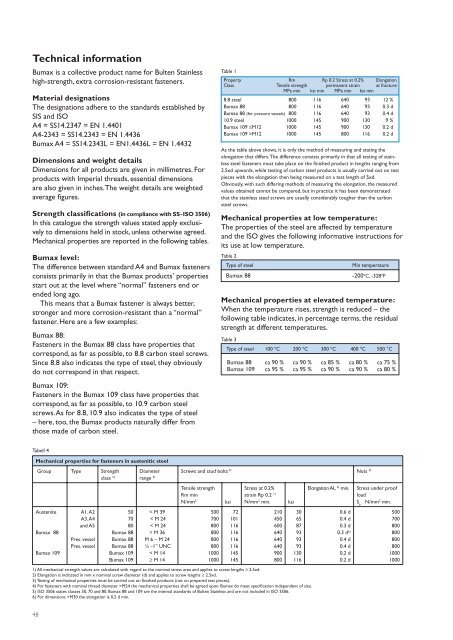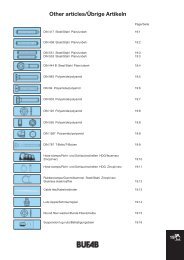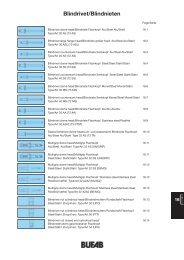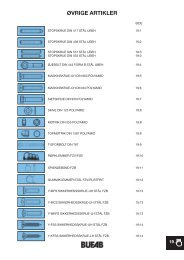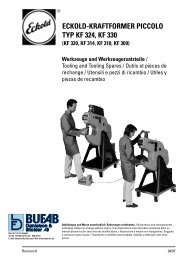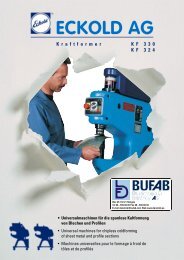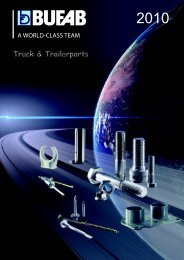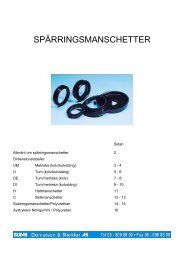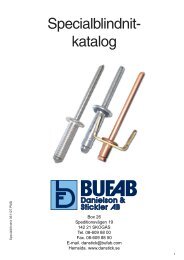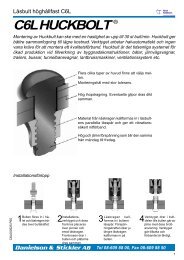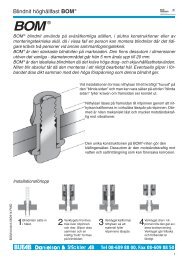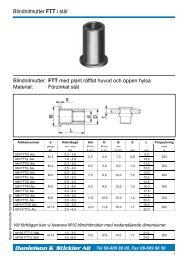Create successful ePaper yourself
Turn your PDF publications into a flip-book with our unique Google optimized e-Paper software.
Technical information<br />
Bumax is a collective product name for Bulten Stainless<br />
high-strength, extra corrosion-resistant fasteners.<br />
Material designations<br />
The designations adhere to the standards established by<br />
SIS and ISO<br />
A4 = SS14.2347 = EN 1.4401<br />
A4-2343 = SS14.2343 = EN 1.4436<br />
Bumax A4 = SS14.2343L = EN1.4436L = EN 1.4432<br />
Dimensions and weight details<br />
Dimensions for all products are given in millimetres. For<br />
products with Imperial threads, essential dimensions<br />
are also given in inches. The weight details are weighted<br />
average fi gures.<br />
Strength classifi cations (in compliance with SS-ISO 3506)<br />
In this catalogue the strength values stated apply exclusively<br />
to dimensions held in stock, unless otherwise agreed.<br />
Mechanical properties are reported in the following tables.<br />
Bumax level:<br />
The difference between standard A4 and Bumax fasteners<br />
consists primarily in that the Bumax products’ properties<br />
start out at the level where “normal” fasteners end or<br />
ended long ago.<br />
This means that a Bumax fastener is always better,<br />
stronger and more corrosion-resistant than a “normal”<br />
fastener. Here are a few examples:<br />
Bumax 88:<br />
Fasteners in the Bumax 88 class have properties that<br />
correspond, as far as possible, to 8.8 carbon steel screws.<br />
Since 8.8 also indicates the type of steel, they obviously<br />
do not correspond in that respect.<br />
Bumax 109:<br />
Fasteners in the Bumax 109 class have properties that<br />
correspond, as far as possible, to 10.9 carbon steel<br />
screws. As for 8.8, 10.9 also indicates the type of steel<br />
– here, too, the Bumax products naturally differ from<br />
those made of carbon steel.<br />
Tabell 4<br />
Mechanical properties for fasteners in austenitic steel<br />
Group Type Strength<br />
class 5)<br />
Austenite<br />
Bumax 88<br />
Bumax 109<br />
A1. A2<br />
A3. A4<br />
and A5<br />
Pres. vessel<br />
Pres. vessel<br />
50<br />
70<br />
80<br />
Bumax 88<br />
Bumax 88<br />
Bumax 88<br />
Bumax 109<br />
Bumax 109<br />
Diameter<br />
range 4)<br />
< M 39<br />
< M 24<br />
< M 24<br />
< M 36<br />
M 6 – M 24<br />
¼ -1” UNC<br />
< M 14<br />
≥ M 14<br />
Table 1<br />
Property Rm Rp 0.2 Stress at 0.2% Elongation<br />
Class Tensile strength permanent strain at fracture<br />
MPa min ksi min MPa min ksi min<br />
8.8 steel 800 116 640 93 12 %<br />
Bumax 88 800 116 640 93 0.3 d<br />
Bumax 88 (for pressure vessels) 800 116 640 93 0.4 d<br />
10.9 steel 1000 145 900 130 9 %<br />
Bumax 109 ≤M12 1000 145 900 130 0.2 d<br />
Bumax 109 >M12 1000 145 800 116 0.2 d<br />
As the table above shows, it is only the method of measuring and stating the<br />
elongation that differs. The difference consists primarily in that all testing of stainless<br />
steel fasteners must take place on the fi nished product in lengths ranging from<br />
2.5xd upwards, while testing of carbon steel products is usually carried out on test<br />
pieces with the elongation then being measured on a test length of 5xd.<br />
Obviously, with such differing methods of measuring the elongation, the measured<br />
values obtained cannot be compared, but in practice it has been demonstrated<br />
that the stainless steel screws are usually considerably tougher than the carbon<br />
steel screws.<br />
Screws and stud bolts 3) Nuts 3)<br />
Tensile strength<br />
Rm min<br />
N/mm 2 ksi<br />
500<br />
700<br />
800<br />
800<br />
800<br />
800<br />
1000<br />
1000<br />
72<br />
101<br />
116<br />
116<br />
116<br />
116<br />
145<br />
145<br />
Stress at 0.2%<br />
strain Rp 0.2 1)<br />
N/mm 2 min. ksi<br />
1) All mechanical strength values are calculated with regard to the nominal stress area and applies to screw lengths ≥ 2.5xd.<br />
2) Elongation is indicated in mm x nominal screw diameter (d) and applies to screw lengths ≥ 2.5xd.<br />
3) Testing of mechanical properties must be carried out on fi nished products (not on prepared test pieces).<br />
4) For fasteners with nominal thread diameter >M24 the mechanical properties shall be agreed upon. Bumax do meet specifi cation independent of size.<br />
5) ISO 3506 states classes 50, 70 and 80. Bumax 88 and 109 are the internal standards of Bulten Stainless and are not included in ISO 3506.<br />
6) For dimensions >M30 the elongation is 0,2 d min.<br />
48<br />
Mechanical properties at low temperature:<br />
The properties of the steel are affected by temperature<br />
and the ISO gives the following informative instructions for<br />
its use at low temperature.<br />
Table 2<br />
Type of steel Min temperature<br />
Bumax 88 -200ºC, -328ºF<br />
Mechanical properties at elevated temperature:<br />
When the temperature rises, strength is reduced – the<br />
following table indicates, in percentage terms, the residual<br />
strength at different temperatures.<br />
Table 3<br />
Type of steel 100 ºC 200 ºC 300 ºC 400 ºC 500 °C<br />
Bumax 88 ca 90 % ca 90 % ca 85 % ca 80 % ca 75 %<br />
Bumax 109 ca 95 % ca 95 % ca 90 % ca 90 % ca 80 %<br />
210<br />
450<br />
600<br />
640<br />
640<br />
640<br />
900<br />
800<br />
30<br />
65<br />
87<br />
93<br />
93<br />
93<br />
130<br />
116<br />
Elongation AL 2) min. Stress under proof<br />
load<br />
S p N/mm 2 min.<br />
0.6 d<br />
0.4 d<br />
0.3 d<br />
0.3 d 6)<br />
0.4 d<br />
0.4 d<br />
0.2 d<br />
0.2 d<br />
500<br />
700<br />
800<br />
800<br />
800<br />
800<br />
1000<br />
1000


